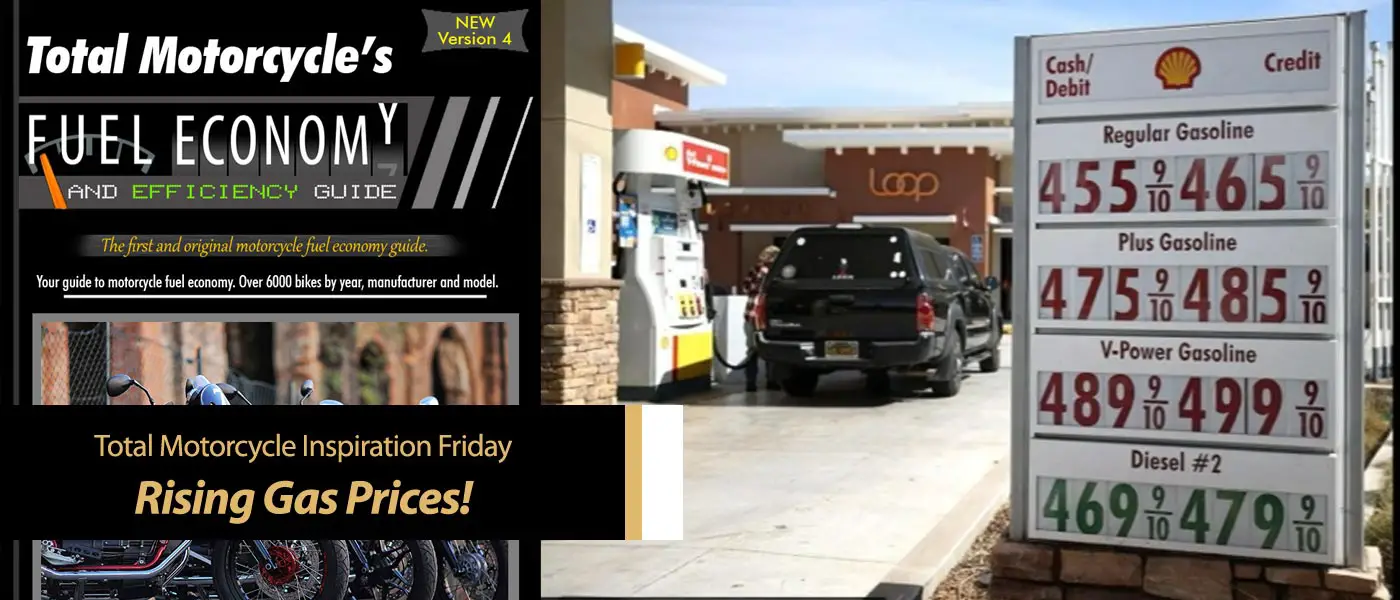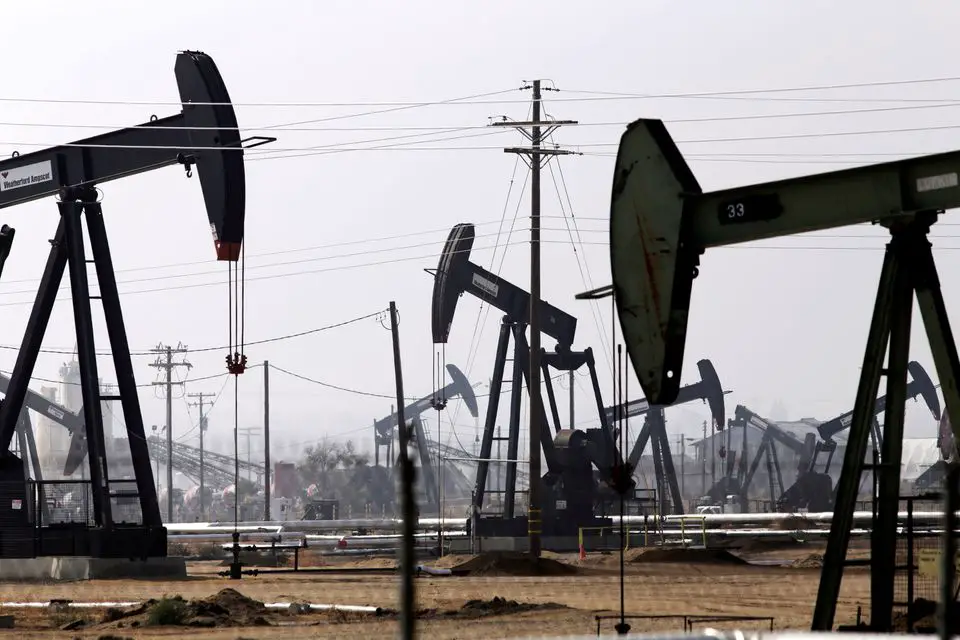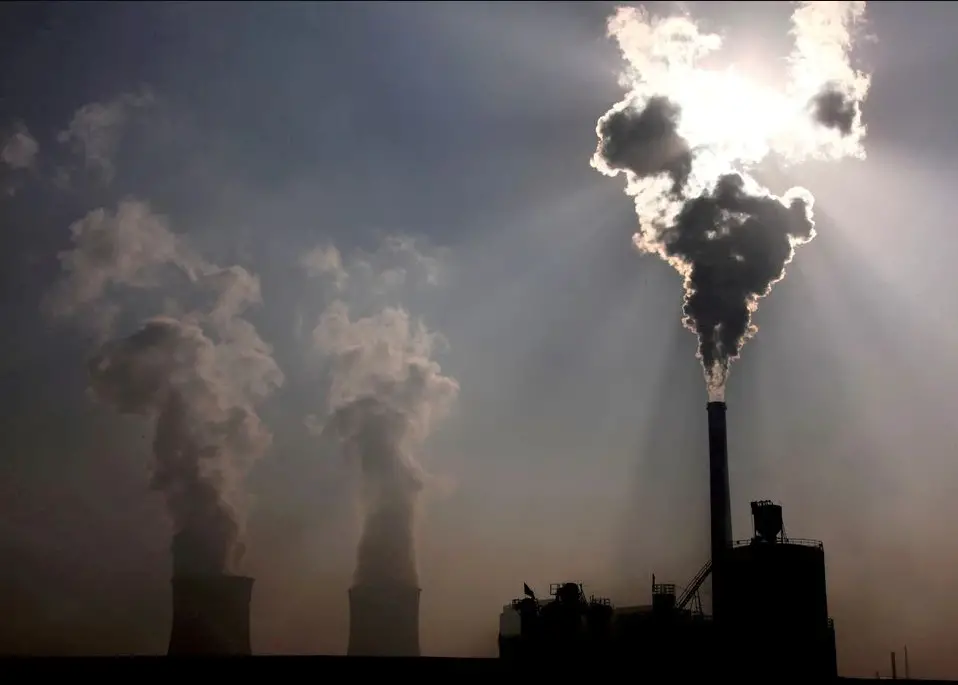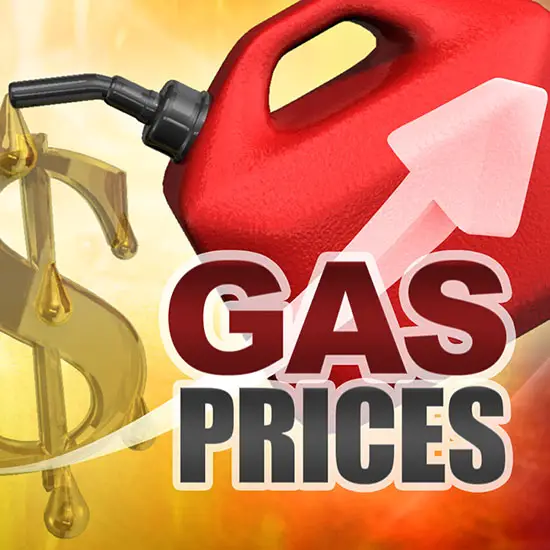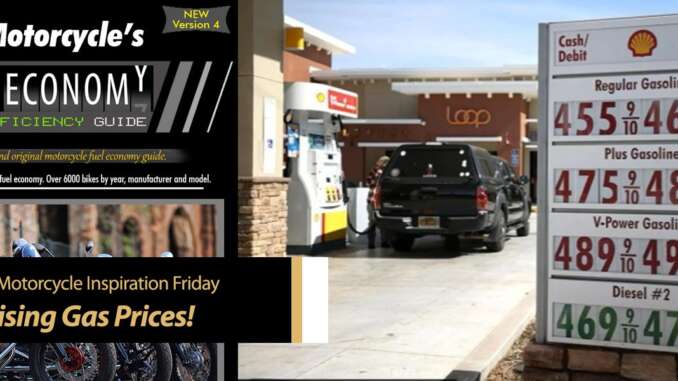
Not my favorite topic but Inspiration Friday: Rising Gas Prices is this weeks hot button around the world. Gas shortages, skyrocketing energy prices, high demand, low supply, canceled pipelines. Back in 2012 Obama said, on multiple occasions, “energy prices will necessarily skyrocket” and “electricity rates would necessarily skyrocket,” he meant it. Thankfully motorcycles ARE the answer, cheaper to insure, cheaper to fuel up, cheaper to maintain, more environmentally friendly, create less traffic jams, cheaper to buy… if only we had a Motorcycle MPG Fuel Economy Guide we could tell what motorcycles are more efficient… oh wait, WE DO! The Total Motorcycle MPG Guide, used worldwide and even by the Government of the United States!
As of writing this, the average per gallon gas price in the USA is $4.11/gallon with $4.65 the highest. In Canada it’s $1.40 with $1.59/liter the highest. And the UK, 142p/litre.
As UN Climate Change Conference (COP26) nears in the city of Glasgow, Scotland, between 31 October and 12 November 2021 we will all see what the future will bring not only for motorcycles and motorcycling but also energy, the stuff we take for granted and use to grow our jobs, business and countries. Stay Tuned!
Below I have highlighted some very recent articles from Newswires and Reuters for you all to read up and learn more on.
It’s time to grab our helmets and show our support! Why not by checking out our latest 2021 and 2022 motorcycle models, joining Total Motorcycle’s new YouTube Membership and $1/mo Patreon channels. Please help us help riders.
Total Motorcycle would like to thank our review staff for inspiring us to bring you this week’s Inspiration Friday: Concorso d’Eleganza Villa d’Este. Each week we bring you another Inspiring Motorcycle story to inspire you to get out and ride!
Global Supply Panic Pushing Energy Prices Up to Multi-Year Highs, Stifel Economics Notes
Oct 06, 2021MT Newswires – Link
The energy price surge across the globe comes as fears of depleted supply has caused panic, Stifel Economics said in a Tuesday note.
West Texas Intermediate crude landed above $77 and reached new highs since 2017, and was also up 60% from the start of the year, Stifel noted.
Supply panic has been spreading globally as India warned it has only four days of coal reserves left and German power plants are said to be running out of fuel. China also reportedly received a coal shipment from Australia despite an import ban, Stifel said.
Demand has surged as economies recover from the crisis and supply continues to be limited by supply chain bottlenecks and logistical disruptions, Stifel said. OPEC+ also stuck to its 400,000 barrel-per-day output hike, despite calls from world leaders to bring more crude onto the market to help ease the global supply shortage.
Average daily crude production in the US is about 7% below the year-ago period and commercial stockpiles of crude are off by 15%, Stifel said, citing data from the EIA.

EIA Sees World Energy Consumption Rising by Nearly 50%
Oct 07, 2021MT Newswires – Link
The US Energy Information Administration forecast that world energy consumption will increase by nearly 50% between 2020 and 2050 due to population and economic growth, particularly with developing economies in Asia, according to its International Energy Outlook 2021 released Wednesday.
Both energy consumption and energy-related carbon dioxide emissions are set to rise through 2050 if current policy and technology trends continue, even with impacts of pandemic-related declines and long-term improvements in energy efficiency, the EIA reported.
Renewables are seen to become the primary source for new electric generation, but natural gas, coal and batteries will also help meet load and support grid reliability, according to the agency. Renewable energy consumption has the strongest growth among energy sources through 2050, but liquid fuels will still be the largest source of energy consumption, driven by the industrial and transportation sectors.
The EIA projects electricity generation to almost double in developing non-OECD countries by 2050, and liquid fuels consumption is expected to grow the most in non-OECD Asia.
Energy Column: How high are oil prices really?
Reuters – By John Kemp – Link
LONDON, Oct 5 (Reuters) – How high are oil prices really and what signal are they currently sending to producers and consumers about the need for more output and lower fuel use?
The strength of a price signal depends on both the real level of prices adjusted for inflation and the rate of change compared with recent years.
In terms of the rate of change, prices are already sending a strong signal about the need to increase production and reduce consumption, as the recovery in demand has outstripped supply after last year’s coronavirus-induced slump.
Front-month Brent futures are currently trading at more than $82 per barrel, up from less than $38 at the end of the same month last year, one of the fastest price increases in percentage terms for three decades.
Rapid price escalation is characteristic of the first year of a cyclical upswing, when consumption bounces back and grows above-trend, while producers continue to withhold output, scarred by memories of the recent slump.
The turnaround from lower/falling prices to higher/rising ones sends a signal about the need for producers to switch from reducing to increasing output, and consumers to conserve fuel rather than be profligate.
But in terms of the level of prices, adjusted for inflation, the current signal to producers and consumers is so far weaker and more ambiguous.
Comparisons with oil prices during previous cycles are distorted by the impact of inflation, which has consistently eroded the value of the U.S. dollar and tended to raise oil futures prices over time.
The impact is relatively insignificant over periods of 2-3 years, small enough to be ignored, but becomes increasingly significant over 5-year to 20-year horizons.
The dollar has lost almost a quarter of its consumer purchasing power since oil prices peaked at more than $140 per barrel in 2008.
If record Brent prices in 2008 are restated at the purchasing power of the dollar in 2021, prices peaked at more than $180 per barrel.
EVALUATING REAL PRICES
Inflation-adjusted prices in the past were much higher than they sometimes appear in retrospect, and current prices are lower than they appear in long-term historical comparisons.
In real terms, front-month Brent prices are currently in the 72nd percentile for all months since 1990, but only the 50th percentile for all months since 2000, and the 56th percentile for all months since 2010.
There is no ideal timeframe over which to evaluate real prices.
Longer comparisons incorporate more cycles but contain older, less relevant data. Shorter time frames are more relevant but contain fewer cycles and may be more distorted by short periods of high or low prices.
In the oil market, 30-year comparisons are distorted by the lengthy period of very low prices in the 1990s, which proved unsustainable, and may not be relevant to decisions a quarter of a century later.
But shorter comparisons since 2000 or 2010 are dominated by the periods of very high prices in 2007-2008 and 2011-2014, which proved equally unsustainable, and may not be relevant to decisions in the 2020s.
The four decades from 1990 to 2030 contain several actual and prospective changes in both production and consumption regimes and behaviour, which makes historical comparisons difficult.
Significant changes include massive excess production capacity in the 1990s, the shale revolution from the early 2010s and the advent of electric vehicles to compete with oil in the 2020s.
However, examining the level of prices in all these time frames, the most conservative conclusion is that the level of real oil prices is currently average or moderately high.
Real prices are sending a signal to producers and consumers about the need for more output and more fuel conservation, but not yet a very strong one.
Further significant price rises may be needed to compel consumers to reduce oil use and switch to cheaper alternatives and encourage producers to boost output.
Energy Column: Europe’s gas prices surge to avert risk of winter shortage: Kemp
Reuters – By John Kemp – Link
LONDON, Oct 6 (Reuters) – Europe’s gas and electricity prices are setting record highs on a daily basis and rising at an accelerating rate as the market tries to destroy enough demand to protect depleted inventories ahead of the winter.
Gas storage sites in the European Union and United Kingdom are currently just under 76% full, compared with a ten-year seasonal average of almost 90%, according to data compiled by Gas Infrastructure Europe.
In the last decade, storage has emptied by an average of 57 percentage points over winter, but depletion is highly variable, ranging from a minimum of 38 points in 2013/14 to a maximum of 71 points in 2017/18.
If this winter sees an average drawdown, storage sites would be reduced to just 19% full by next spring, the second lowest for a decade, leaving the region with a persistent gas shortage next year.
If the winter sees a moderately strong draw, in the 75th percentile, storage would be reduced by 68 percentage points to a record low of just 8% next spring, increasing the probability supply will actually run out in some areas.
Futures prices are rising to avert this threat by rationing demand now to conserve inventories and reduce the risk of running out later in the winter.
Sharply rising prices are the reason wholesale markets (such as European gas) rarely run into physical shortages, unlike retail markets (U.K. gasoline and diesel) where price rises are typically more limited for commercial and political reasons.
Europe’s gas and electricity prices are likely to remain elevated until there is clear evidence that they have begun to reduce demand and conserve inventories.
There are tentative signs the inventory situation has already improved slightly since late August in response to much higher prices, but the market may need a much stronger signal of conservation before prices fall.
The most likely early signs of conservation are temporary factory closures (especially energy-intensive users); reductions in central and local government energy consumption (street lighting and building temperatures); and reductions in commercial and residential consumption (building temperatures).
Until there is a clear signal consumers have begun to respond by reducing gas use, prices are likely to remain exceptionally high to avert a much worse situation early next year.
Energy China digs in on coal, oil gains as energy crisis deepens
Reuters – By Chen Aizhu and Sonali Paul – Link
Oct 8 (Reuters) – China ordered miners in Inner Mongolia to ramp up coal production and oil prices jumped on Friday as a record surge in the cost of gas revived demand for the most polluting fossil fuels to keep factories open and homes heated.
The rebound in economic activity from coronavirus restrictions has exposed alarmingly low supplies of natural gas leaving traders, industry executives and governments scrambling as the northern hemisphere heads into winter.
The energy crisis, which has led to fuel shortages and blackouts in some countries, has highlighted the difficulty in cutting the global economy’s dependency on fossil fuels as world leaders seek to revive efforts to tackle climate change at talks next month in Glasgow.
In China, where coal production had been curtailed to meet climate goals, officials have ordered more than 70 coal mines in Inner Mongolia to ramp up production by nearly 100 million tonnes or 10%, as the world’s largest exporter battles its worst power shortages in years.
Russia’s Gazprom, a key supplier of gas to China, calmed fears that a fire at a major gas processing plant could worsen the situation, saying it was able to continue exporting gas to China as normal.
India, the second largest coal consumer after China, is also suffering electricity outages because of a lack of coal with over half of its coal-fired power plants having less than three days worth of fuel stocks, data from the federal grid operator showed.
Oil prices rose on Friday, on track for gains of nearly 5% this week, as industries switch fuel.
“A lot of catalysts are out there to keep the oil market tight,” said Edward Moya, a senior market analyst at brokerage OANDA.
Reflecting the gravity of the situation, the United States has not ruled out tapping into its strategic petroleum reserves, which it typically only does after major supply disruptions such as hurricanes, or pursuing a ban on oil exports to bring down the cost of crude oil, though there are doubts it is ready to take such action yet.
“DOE is actively monitoring global energy market supply and will work with our agency partners to determine if and when actions are needed,” a spokesperson for the Department of Energy said.
Global fuel shortages are another blow to a world economy just getting back on its feet after the coronavirus pandemic and threaten an expensive winter for consumers.
China is going to allow coal-fired power prices to fluctuate by up to 20% from base levels, instead of 10-15% previously, in order to prevent high energy consumption, state broadcaster CCTV reported on Friday, citing a meeting of the State Council, or cabinet.
Bangladesh, meanwhile, bought two cargoes of liquefied natural gas (LNG) for delivery in October at record prices, two industry sources said on Friday, as low stocks in Europe boosts competition with Asia for supplies.
“It is really tough to cope with such abnormal prices. At the moment, we have no other option but to buy to keep economic activities going,” an official of state-run Petrobangla, which oversees LNG supplies, said.
Bangladesh is reviewing leases of five oil-fired power plants which are nearing expiry, despite its plan to move from oil towards natural gas for power generation.
Even before the current energy crisis erupted, the world was far behind on efforts to avert catastrophic climate change with a United Nations analysis estimating that global emissions would be 16% higher in 2030 than they were in 2010 based on countries’ current pledges.
Surging energy prices are stoking tensions in Europe over the green transition. Wealthier nations want to keep up the pressure to quit fossil fuels while poorer ones, worried about the cost to the consumer, are wary.
Britain’s energy regulator warned that energy bills, which have just been hiked, are likely to rise significantly in April due to high wholesale costs which have forced some suppliers out of business.
Divisions within the European Union have deepened, with Hungary’s Prime Minister Viktor Orban blaming European Union action to combat climate change for the current crisis and saying Poland and Hungary would present a united front at the next EU summit.
Analysts have said rising gas prices are the main driver of European electricity costs, while the soaring cost of permits on the EU carbon market has contributed around a fifth of the power price increase.
Writing by Elaine Hardcastle; Editing by Carmel Crimmins

Michael Le Pard (“Mr. Totalmotorcycle”) is the Founder of Total Motorcycle, the world’s largest motorcycle information site, trusted by over 430 million riders since 1999. With over 34 years of experience in motorcycles, gear and rider culture, he has built a global community dedicated to empowering and inspiring motorcyclists.
Total Motorcycle remains his passion project. Combining expert research, hands‑on knowledge and a commitment to helping riders make informed decisions about bikes, gear and safety worldwide.


